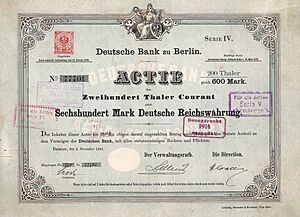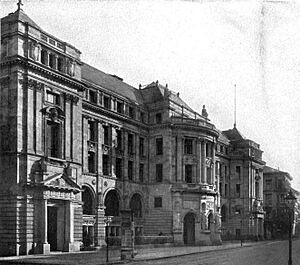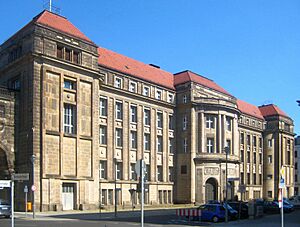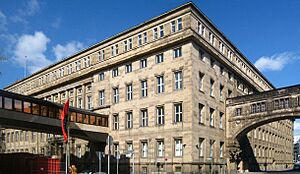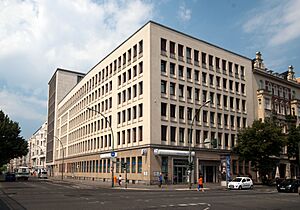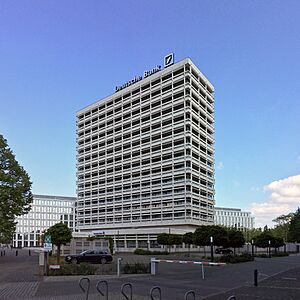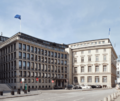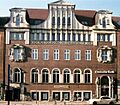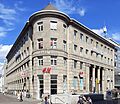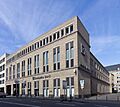Deutsche Bank facts for kids
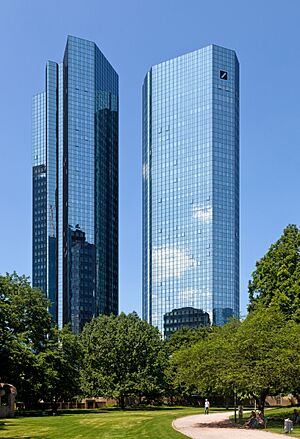
Deutsche Bank Twin Towers in Frankfurt, Germany
|
|
| Public | |
| Traded as | |
| ISIN | ISIN: [https://isin.toolforge.org/?language=en&isin=DE0005140008 DE0005140008] |
| Industry | Financial services |
| Founded | 10 March 1870 |
| Founders |
|
| Headquarters | Deutsche Bank Twin Towers,
,
Germany
|
|
Key people
|
|
| Products |
|
| Revenue | |
|
Operating income
|
|
| AUM | |
| Total assets | |
| Total equity | |
|
Number of employees
|
89,753 (2024) |
Deutsche Bank AG is a big German bank and financial company. Its main office is in Frankfurt, Germany. It is known as one of the largest banks in Germany.
The bank started in 1870 in Berlin. Over the years, it grew by joining with other banks. It also bought companies like Morgan Grenfell and Bankers Trust. By 2018, Deutsche Bank had offices in 58 countries around the world. It is a very important bank for the global financial system.
Deutsche Bank has faced some challenges and legal issues over the years. However, it continues to be a major player in the banking world.
Contents
History of Deutsche Bank
Starting in 1870
Deutsche Bank began in 1870 in Berlin. It was created to help Germany trade with other countries. It also helped German companies grow by giving them money. Before Deutsche Bank, German traders often had to rely on British and French banks.
Some of the people who helped start the bank included Adelbert Delbrück and Ludwig Bamberger. The first directors were Wilhelm Platenius, Georg von Siemens, and Hermann Wallich. The bank opened its first branches in Germany in Bremen and Hamburg in 1871 and 1872. Soon after, it opened offices in places like Shanghai, Yokohama, and London.
The bank helped fund big projects like the Baghdad Railway and supported companies like Krupp and Bayer. It also teamed up with other banks in Germany to expand its reach.
Changes and Challenges (1914-1945)
During World War I, some of Deutsche Bank's offices in other countries were taken over. After the war, in 1929, Deutsche Bank joined with another bank called Disconto-Gesellschaft. For a while, it was known as Deutsche Bank und Disconto-Gesellschaft.
When Adolf Hitler came to power in Germany, Deutsche Bank became involved with the Nazi government's policies. The bank removed its Jewish board members and was involved in taking over Jewish-owned businesses. It also helped with financial transactions during the war. In 1999, Deutsche Bank admitted its involvement and contributed to a fund for Holocaust survivors.
After World War II (1945-2000)

After World War II, the bank was split into smaller regional banks. But in 1957, these banks came back together to form Deutsche Bank AG, with its main office in Frankfurt.
In 1959, Deutsche Bank started offering small personal loans to regular people. In the 1970s and 1980s, it expanded internationally, opening offices in places like Milan, Moscow, and Tokyo. It also bought other banks, like Banca d'America e d'Italia.
In 1989, Alfred Herrhausen, who was the chairman of Deutsche Bank, was sadly killed in an explosion. Later that year, the bank bought Morgan Grenfell, an investment bank in the UK. In 1998, it bought Bankers Trust, a large US firm. These purchases helped Deutsche Bank become a major player in international finance.
Deutsche Bank in the 21st Century
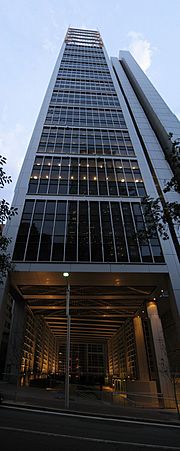
In 2001, Deutsche Bank was listed on the New York Stock Exchange. This was a big step for the bank. Over the next few years, it continued to grow by buying other companies. These included Scudder Investments and the Russian investment bank United Financial Group. In Germany, it bought banks like Norisbank and Deutsche Postbank, which helped it offer more services to regular customers.
The bank's headquarters, the Deutsche Bank Twin Towers, were renovated to be very energy-efficient. In 2010, Deutsche Bank even owned a casino in Las Vegas for a few years after its original owner had problems.
Deutsche Bank has faced some financial challenges and legal investigations, including those related to past financial practices. The bank has worked to resolve these issues. In 2019, the bank announced a major plan to cut jobs and focus on its most competitive areas.
In 2020, Deutsche Bank reported its first annual profit since 2014. In 2021, it successfully managed a situation involving Archegos Capital Management, avoiding major losses. As of 2025, the bank continues to make changes to its leadership and business strategies.
Recent Acquisitions
Deutsche Bank has continued to grow by acquiring other companies. Some of these include:
- Scudder Investments (2001)
- RREEF (2002)
- Norisbank (2006)
- Hollandsche Bank-Unie (2008)
- Sal. Oppenheim (2010)
- Deutsche Postbank (2010)
- Park Plaza Mall (2021)
- Numis (2023)
How Deutsche Bank Works
Deutsche Bank has three main parts:
- Corporate & Investment Bank (CIB): This part helps large companies and financial groups with things like mergers, buying and selling stocks, and managing money.
- Private & Commercial Bank: This is the part that serves regular people and smaller businesses. In Germany, it operates under the Deutsche Bank and Postbank names. It also has operations in other countries like Belgium, Italy, and India.
- Deutsche Asset Management (DWS): This part manages money for investors. Deutsche Bank owns most of this company.
Leadership at Deutsche Bank
The bank has had many leaders since it started. Here are some of the people who have led Deutsche Bank:
- Hermann Josef Abs (1957–1967)
- Franz Heinrich Ulrich (1967–1976)
- Wilfried Guth (1976–1985)
- Friedrich Wilhelm Christians (1976–1988)
- Alfred Herrhausen (1985–1989)
- Hilmar Kopper (1989–1997)
- Rolf-Ernst Breuer (1997–2002)
- Josef Ackermann (2002–2012)
- Anshu Jain (2012–2015)
- Jürgen Fitschen (2012–2016)
- John Cryan (2015–2018)
- Christian Sewing (since 2018)
Images for kids
-
Branch in Hamburg first opened 1872, current buildings erected 1896-1897 (right) and 1951-1953 (left)
-
Former branch in Munich
-
Branch in Leipzig, former Leipziger Bank
-
Branch in Bremen
-
Branch in Hanover, former Hannoversche Bank (taken over by Deutsche in 1920)
-
Branch in Lübeck, former Commerz-Bank
-
Branch in Düsseldorf
-
Branch in Goslar
-
Branch in Karlsruhe
-
Branch in Cologne, former head office of Sal. Oppenheim
-
Branch in Bochum
See also
 In Spanish: Deutsche Bank para niños
In Spanish: Deutsche Bank para niños




